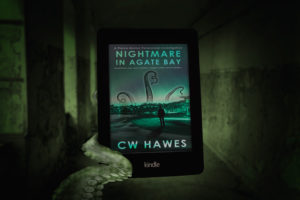
Anyone familiar with drama knows about the Fourth Wall. It’s that invisible wall that separates the world of the play from the world of the audience. The Fourth Wall prevents the characters from knowing the audience exists, while letting the audience observe the world of the characters in the play.
In literature, this is known as Secondary Belief. The world of the story is separate from the world of the reader. And as long as the world of the story is believable — even though perhaps very different from the world of the reader — the reader will accept it and be entertained.
Magic acts, for example, work on this principle. The audience knows the woman is not cut in half, but accepts what it sees as real in order to be entertained.
In order for the Fourth Wall, or Secondary Belief, to work two things must happen:
- The writer must make the fictional world believable
- The audience/reader must accept the fictional world as believable.
The Burden of the Writer
How does the writer make the fictional world believable? That is the burden of the storyteller — to create a consistent world that, because of its consistency, is believable.
The operative word here is consistent.
For example, we know there are no such things as orcs, or hobbits, or elves, or a place called Middle Earth. However, JRR Tolkien created his world so that it was consistent and therefore appears real and believable to us. And we are thus entertained by the story.
The Burden of the Audience
The audience/reader knows when he or she reads a novel, or watches a movie, that the story or movie is fiction. It is not true. That is what it is called Primary Belief.
However, if the world comes across as realistic and consistent, and therefore believable, the audience/reader will choose to believe what is going on as though it is true. That is Secondary Belief.
If the writer fails to make the story completely believable, or consistent, the audience can choose to suspend disbelief in order to continue to be entertained.
However, once the audience can no longer suspend disbelief, the writer has completely failed.
The Storyteller’s Art
A good storyteller draws you in. Sometimes without you even fully knowing it.
Saki, in “Sredni Vashtar”, starts with a sickly boy, Conradin. Saki paints us a picture of Conradin that we find believable. Perhaps because the boy is like us. We learn of Conradin’s world and of his over protective aunt. And slowly, slowly we find ourselves on Conradin’s side in his struggle with his aunt — because it is also our struggle against authority. We believe because something similar has happened to us. The author has hooked us without our even knowing it.
But he couldn’t have done that if the world of the story wasn’t consistent and therefore believable.
A poor storyteller may hit all the plot points on the head and may pack the story with action on every page, but if the tale isn’t consistent within what we understand to be believable — we will feel the story to be artificial and not ring true. And sadly forgettable.
Recently I started reading a novel where the main character was bonded with some sort of sentient cat and even though they couldn’t stand each other they couldn’t separate because of their bond. That was difficult to believe, but I accepted it and continued reading.
But when the cat kills several people and the townsfolk just stand around and look at the dead bodies, don’t call the authorities, and don’t do anything against the cat and main character, who are outsiders, the writer lost me. Where is that a normal reaction to murder? Certainly not in my world.
In addition, the plotting was so wooden, mechanical, and obvious I found it too painful to continue. It was writing on par with a paint by numbers kit.
The key to telling a good story is consistency in the fictional world. There’s a reason for the old saying that fiction must be believable, whereas real life doesn’t.
We can except the inconsistencies in real life, even though they might not make sense, because that is how real life is. But we are intolerant of those same inconsistencies when it comes to fiction. The fictional world must hang together. It must be reasonable. That is just how we are.
The advantage of traditional publishing is that the editor at the publishing house will reject any manuscript that is unbelievable. We the reader are spared, for the most part, lousy stories. That isn’t always the case, but mostly.
Indie authors have no such gatekeeper — other than their readers. Even if the author uses an editor, there is nothing to make the writer incorporate the editor’s suggestions.
The biggest failing I find among indie authors is that their storylines, characters, and the world of the story lack consistency. They simply aren’t believable. Sometimes I can suspend disbelief, but most of the time the books are just too bad to do so.
Therefore my advice to would-be authors is to make sure your characters are consistent with themselves, that there are no gaping holes in your fictional world (in other words, that your world is consistent), and that your storyline flows naturally and doesn’t appear to have been written by the numbers.
We readers want to believe. You writers, help us to believe by being consistent.
Comments are always welcome. And until next time, happy reading!



Yes, yes, yes. I agree completely with what you said here:
“The advantage of traditional publishing is that the editor at the publishing house will reject any manuscript that is unbelievable. We the reader are spared, for the most part, lousy stories. That isn’t always the case, but mostly.
Indie authors have no such gatekeeper — other than their readers. Even if the author uses an editor, there is nothing to make the writer incorporate the editor’s suggestions.”
That’s a tricky thing about indie publishing and one reason that having a good editor and/or beta readers is so helpful–if one takes their advice! 🙂
If one takes their advice is certainly key. And that necessitates an attitude on the writer’s part to think of the best product he or she can give to the reader. A diminishing of the ego for the sake of the story and the reader. Thanks for stopping by, JP!
Good points! I see it as a 4 way encounter between the author’s and reader’s Inner Children and their Inner Editors. The author’s Inner Child wants to tell a cool tale and the Reader’s Inner Child wants to enjoy it. BUT both their Inner Editors want the tale to make sense and satisfy their minds as well as their hearts. Satisfy (or at least gratify) all four and the tale succeeds.
Last year I ran the first 100+ pages of my WIP past a professional editor. He found a significant plot hole, which took me more time and effort than I expected to repair. I was shocked at first, but then decided one plot hole per 100+ pages is not bad considering how deliberately outrageous my tale is at times.
Mind you. Readers’ tolerance for Points of Improbability varies widely. For example, I agree with one of my closest friends on most things, except he simply does not get SF and Fantasy.
I love your 4-way encounter description! It’s brilliant! And you are right, just like beauty is in the eye of the beholder, readers have different Points of Improbablility. Which is why there can be so many artists and writers!
Those plot holes do happen. I think mostly because we writers know the story and we just forget to put crucial pieces of info on the paper. It’s good you caught yours before the book came to an end!